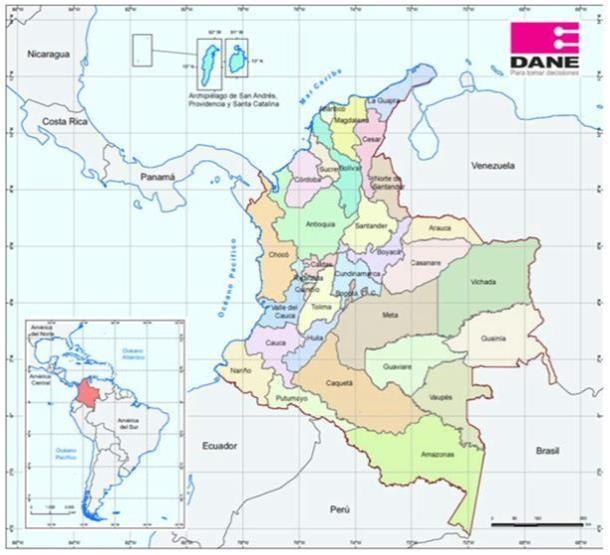INTRODUCTION
From 2014 to 2018, Colombia experienced real Gross Domestic Product (“GDP”) growth every year. Real GDP grew by 4.7% in 2014, 3.0% in 2015, 2.1% in 2016, 1.4% in 2017 and 2.6% in 2018. The growth of GDP in 2018 was mainly due to increases in domestic demand, private consumption and gross capital formation.
During 2018, all economic sectors experienced positive growth, with the exception of mining and quarrying. The sectors that grew the most during 2018 were professional activities, scientific and technical (5.0%) and public administration and defense, education and health (4.1%). Manufacturing (2.0%), agriculture, livestock, fishing, forestry and hunting (2.0%) and construction (0.3%) also experienced growth. The only sector that experienced a contraction was mining and quarrying (-0.8%).
Inflation, as measured by the change in the consumer price index, was 3.7% in 2014, 6.8% in 2015, 5.8% in 2016, 5.0% in 2017 and 3.5% in 2018. Inflation was lower in 2018 than in 2017 mainly due to a minimal increase in the prices of foods and communications, both experiencing approximately 0.1% inflation. The item that registered the highest increase in price during 2018 was housing with 1.3%.
Due to the implementation of trade and foreign exchange liberalization policies, Colombia has experienced current account deficits in most years since 1994. In 2014, the current account registered a deficit of $19,764 million, the trade account recorded a deficit of $4,641 million, and the financial account registered a deficit of $19,292 million. In 2015, the current account deficit decreased to $18,564 million, the trade deficit increased to $13,479 million and the financial account deficit decreased to $18,244 million. In 2016, the current account deficit decreased to $12,036 million, the trade deficit decreased to $9,176 million and the financial account deficit decreased to $12,273 million. In 2017, the current account deficit decreased to $10,241 million, the trade deficit decreased to $4,470 million and the financial account deficit decreased to $9,558 million. In 2018, the current account deficit increased to $13,037 million, the trade deficit increased to $5,143 million and the financial account deficit increased to $12,640 million.
In 2018, exports of coal totaled $57.9 million, or a 0.8% increase, while exports of oil and its derivatives totaled $3,609.6 million, or a 27.4% increase, and exports of nickel totaled $197.9 million, or a 54.9% increase, compared to 2017.
Foreign direct investment recorded a decrease in the capital account in 2018 of 20.4% compared to 2017. Foreign direct investment decreased primarily as a result of a decrease in investments in sectors such as transportation, storage and communications, manufacturing, and electricity gas and water. In 2014, net foreign investment stood at $16,167 million. In 2015, net foreign investment decreased to an inflow of $11,723 million. In 2016, net foreign investment increased to an inflow of $13,850 million. In 2017, net foreign investment increased to an inflow of $13,836 million. In 2018, net foreign investment decreased to an inflow of $11,010 million, a $2,826 million decrease compared to 2017.
Net international reserves at year end decreased from $47,323 in 2014 to $46,731 in 2015. At the end of 2016, net international reserves totaled $46,675 million and increased to $47,629 million in 2017. By the end of 2018, net international reserves increased to $48,393 million. According to preliminary figures, net international reserves at April 30, 2019 stood at $51,522 million.
Since 2014, Colombia’s ratio of total net non-financial public sector debt to GDP has increased from 38.7% of GDP in 2014 to 43.1% in 2015, 43.2% in 2016, 44.9% in 2017 and 47.2% in 2018. Colombia’s non-financial public sector recorded a deficit of 1.8% of GDP in 2014, 3.4% of GDP in 2015, 2.4% of GDP in 2016, 2.7% of GDP in 2017 and 2.9% in 2018. The Central Government’s deficit was 2.4% of GDP in 2014, 3.0% of GDP in 2015, 4.0% of GDP in 2016, 3.6% of GDP in 2017 and 3.1% of GDP in 2018.
On June 13, 2016, the executive board of the International Monetary Fund (“IMF”) approved a two-year arrangement under the IMF’s Flexible Credit Line (“FCL”) in SDR 8.18 billion, equivalent to approximately $11.5 billion. This two-year arrangement was a successor arrangement to the two-year FCL for SDR 3.87 billion, approved in June 2013. On May 25, 2018, the Executive Board of the IMF approved a
D-5
